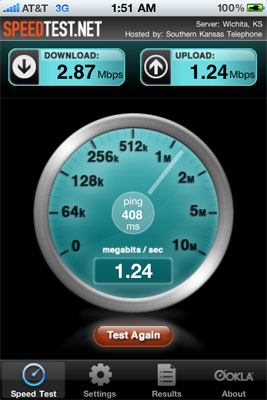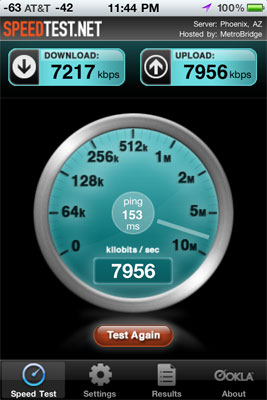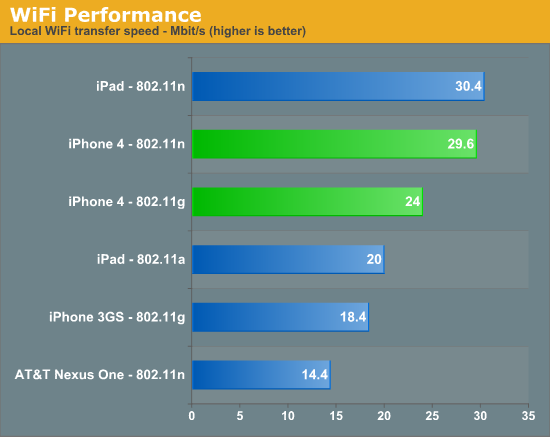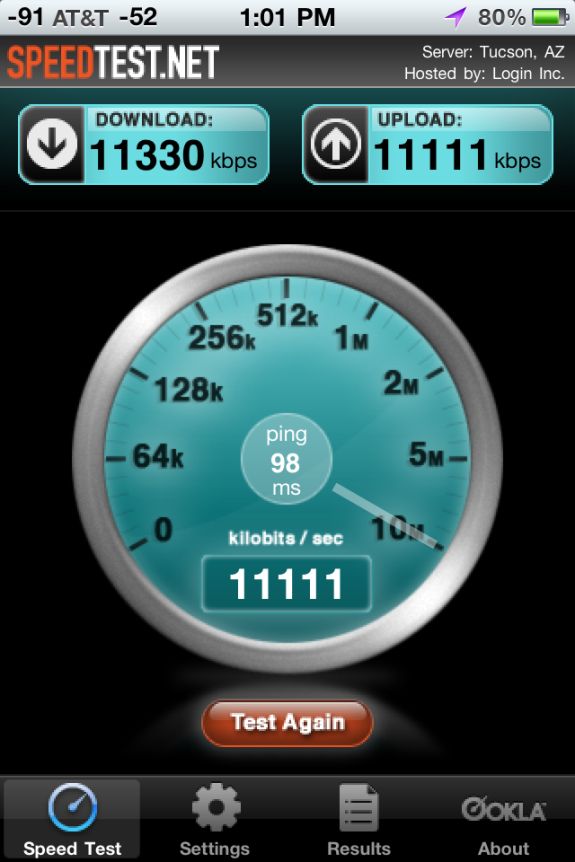Apple's iPhone 4: Thoroughly Reviewed
by Brian Klug & Anand Lal Shimpi on June 30, 2010 4:06 AM EST- Posted in
- Smartphones
- Apple
- iPhone 4
- Gadgets
- Mobile
Network Improvements
The iPhone continues to be an AT&T exclusive in the US. With the iOS 4 upgrades the iPhone 4 supports tethering over Bluetooth or USB. The feature is an extra $20 per month on top of your existing iPhone data plan and it also deducts bandwidth from the 2GB you get with the data plan. It's not a coincidence that AT&T timed the release of its iPhone tethering option with the move away from unlimited data plans. You don't have to give up your existing unlimited data plan if you don't want to, however if you want to enable tethering you have to sign up for the new $25/2GB plan.
I'm not a huge fan of iPhone tethering right now because despite paying for the service and having full signal strength on AT&T, I'm getting horrible transfer rates while trying to upload this article. I had to sign up for airport WiFi to get it live, thanks AT&T. When it does work however, it works well. As you'll see later you can easily get multiple Mbps out of AT&T's network in areas with good coverage. That easily equals the lower end of what you'd see from WiMAX today. As I've mentioned before however, it's really hit or miss with AT&T. The network is either great or totally unusable, while its competitors are generally more consistent but never quite as fast. I'd say that there's a good chance Apple will bring the iPhone to Verizon, it's just a matter of when.
| Cost of Ownership Comparison | |||||
| AT&T iPhone 4 | Sprint EVO 4G | Verizon HTC Droid Incredible | |||
| Cost of Device | $199 w/ 2 year contract | $199 w/ 2 year contract after $100 MIR | $199 w/ 2 year contract | ||
| Plan with 900 Minutes, Unlimited SMS/Data | $104.99/mo, unlimited SMS, 2GB data | $99.99/mo, unlimited SMS, unlimited data, 4G | $109.98/mo, unlimited SMS, unlimited data | ||
| Tethering | + $20/mo | + $29.99/mo | + $25/mo* | ||
| Total Monthly + Tethering | $124.99/mo | $129.98/mo | $134.98/mo | ||
| Total Cost of Ownership over 2 Years | $2718.76 | $2598.76 after $100 MIR | $2838.52 | ||
| Total Cost of Ownership over 2 Years w/ Tethering | $3198.76 | $3318.52 after $100 MIR | $3438.52 | ||
AT&T's plans are actually reasonably priced if you don't go over the data limits. A $15/mo data plan will get you 200MB of transfers per month and $25 will give you 2GB. For users like my parents the 200MB option is great. Even for me personally, 2GB is fine. I tend to peak at 700MB per month, but that's because at the office I'm almost always on my desktop or connected via WiFi. It's unclear how tethering is going to change this for me. Our own Brian Klug on the other hand easily pushes more than 2GB of transfers per month. So AT&T's rate switch is either going to save you a few bucks per month or make you really unhappy.
The iPhone 4 brings HSUPA class 6 for upload speeds of up to 5.76 megabits/s to the platform. This is a 15 fold improvement over the 384 kilobits/s maximum of the iPhone 3G and 3GS, which I routinely see. Not all AT&T markets are updated to HSUPA, and in practice I saw uploads of around 1.5 megabits/s, in line with class 2 or class 3 HSUPA.
Downstream HSDPA speeds remain unchanged from the 3GS, supporting up to 7.2 megabit/s HSDPA. I'm lucky since my market is HSDPA 7.2, as I routinely see speedtests of 5 megabits/s or above very late at night when there isn't very much plant load. I haven't seen any measurable increase in speeds over the 3GS, except in locations with very low signal as noted before.

My fastest iPhone 4 speedtest so far
Even Anand in one of the slowest 3G cities in the US saw significant improvements with the iPhone 4. AT&T's network in general seems to be improving. While the best he'd been able to achieve was around 1Mbps a year ago, these days he can break 2.5Mbps down during the evenings.

iPhone 4 speedtest in Raleigh, NC
WiFi speeds have also improved, as Apple has added 802.11n in the 2.4 GHz band. 5 GHz support remains absent, something which would have likely complicated antenna design even further. Interestingly enough, the BCM4329 WiFi and Bluetooth SoC does contain 802.11a 5 GHz support, the reason it's disabled is again likely due to antenna design constraints. The Broadcom SoC also includes an FM tuner and transmitter, though support for either remains and sadly (given Apple's historical lack of FM radio support) will remain such. Bluetooth 2.1 EDR is there as well.
The iPhone 4 seems to connect at 802.11n rates of 72 megabits/s in best case, far from the maximum without channel bonding of 150 megabits/s. This is still a welcome improvement from the 802.11b/g in the iPhone 3GS, which seemed to never connect above b rates in practice. As an aside, mobile devices using 802.11b rates (modulated using DSSS) are a huge contributing factor to WiFi congestion at conferences - I've even seen DSSS modulated rates (and thus 802.11b devices) explicitly disallowed from connecting to APs at conferences. It's a welcome improvement to see iPhone bringing N support.

A typical WiFi test result
However, even on my 25/4 DOCSIS 3 cable connection, I could only squeeze out a maximum of 8.5 megabits/s down and 8.0 megabits/s up while connected at 72 megabits/s best case. This was using the speedtest.net app to a local test location. I tried with an Airport Extreme (new generation), a WRT600N running DD-WRT, and a WRT54GL-TM running Tomato. All three showed similar results capping out around 8 megabits/s down when I could run tests in excess of 30 megabits down on my desktop. This is probably more of a CPU bottleneck appearing than anything else.
Update:
I thought there was something wrong with my WiFi performance, turns out the iPhone 4 is indeed faster than a palty 8 megabits/s. ;)
There were a number of comments by folks who were able to run speedtest.net and get throughput above 10 or 11 megabits/s. Testing earlier today on a much faster connection, I managed to get something in line with their numbers:
Early today, the folks at DigitalSociety also managed to get much faster WiFi speeds in the neighborhood of 20 megabits/s, way higher than my meager 8 megabits/s. To do so, they loaded an MP3 in safari stored on a local webserver and watched network utilization. I wish I had thought of this, because it's perfect. In the past, the speedtest.net app always used to saturate my connection over WiFi. My only explanation is that the application performs slower over WiFi in iOS 4 than it did in iOS 3, something Anand noted as well. Thanks for all the heads up messages, everyone!
I set up a similar test to DigitalSociety's. I opened an 85 MB PDF stored on my local web server in the browser of each device and watched network utilization using bwm-ng. I tested with an Airport Extreme connected over gigabit to my webserver with no other network utilization. I took the average of 5 runs on the iPad, iPhone 4, iPhone 3GS, and my AT&T Nexus One running Froyo 2.2 (which is 802.11n). The results are much, much more in line with earlier expectations.

The iPhone 4 comes close to but can't quite best the iPad, though the difference is minimal. I did notice that the iPad associates at the same 72 megabits/s connection speed as the iPhone 4. Thankfully, the iPhone 4 easily bests the iPhone 3GS. Finally, although the AT&T Nexus One associates at an 802.11n rate of 65 megabits/s, it's slower than the iPhone 3GS. I have a feeling the device is writing the PDF into flash, whereas the iOS devices are loading it into memory.











270 Comments
View All Comments
Dark Legion - Wednesday, June 30, 2010 - link
Not to be a grammar nazi, but since I'm posting other things anyway..."Even Palm entered the race with a competent offering, and Microsoft isn't far behind."
Both the Evo and Incredible have 8GB built in + room for 16GB microSD (though they come with 8GB microSD?), and the Incredible also has dual LED flash.
SimKill - Wednesday, June 30, 2010 - link
I just printed this to a PDF, and its 75 freaking pages... Holy bleeding batman(in a good way) It's longer than even some magazines, 1 article.AWESOME
(I think it would be perfect on a Kindle...hmm next thing to buy :evilgrin: )
It's going to make for a nice evening read.
griffonu - Wednesday, June 30, 2010 - link
Really cool review! The first informative one in a general noise of non-sense and subjective opinions on the net./bow
Furuno - Wednesday, June 30, 2010 - link
I don't now what should I say about those $29.99 bumper case... It's even more expensive than my $15 "backup" phone...And I wonder why you're so excited about video call? isn't this is an old technology already? I've been doing this since high school with Nokia 3G's phone (forget the name).
I still prefer N900 tough, mostly because of it's Debian-based OS. As a programmer that's usually works with a Linux machine it's just incredible. Like, wow I can do apt-get install on my phone!
Oh, and thanks for the in-depth antenna issue explanation! Great article!
Griswold - Wednesday, June 30, 2010 - link
I'd rather like to know what apple says about the bumper cases. They cost them maybe a dollar at the most to make and they sell it for 29 bucks. Thats a fucking fat cash cow right there and it explains why they refuse to hand one out for free. What would you rather have? $2m spent in a couple weeks for satisfied customers or $56m profit from partly annoyed customers?(yea I read it, the issue is not really an issue and not everyone is going to buy a bumper case... its anecdotal)
JAS - Wednesday, June 30, 2010 - link
Indeed, Apple's pricing for its Bumper is outrageous. Who would pay $29 for a small piece of plastic? But if you are running a corporation, have a legal responsibility to shareholders to maximize profits, *and* customers are willing to buy a product at the listed price ... ?How long will it be until a third-party case maker introduces its own perimeter case for under $10?
kmmatney - Wednesday, June 30, 2010 - link
It won't be long at all. I bought by 3GS rubber case for ~$2 on dealextreme. It's now even cheaper:http://www.dealextreme.com/details.dx/sku.11687#op... full view
I agree that they should give away the cases for free, or heavily discounted . In any case, I don't anyone is crazy to not use a case on such an expensive device. You're going to drop it sometime.
Screammit - Thursday, July 1, 2010 - link
I'd have to agree with the video call bit, other phones (evo in particular) can do video calls over 3g AND can interface with computers through applications like Fring and Skype. I'm sure the video quality to only other iphone 4 users is stellar, especially over wifi, but isn't it a tad restrictive?archcommus - Wednesday, June 30, 2010 - link
I'm sorry, as much as I love Anandtech and Anand's in-depth and candid articles in particular, the bias here towards Apple is extremely strong. This article is night and day compared to the EVO review just posted. This is direct, interesting, discusses real impressions - EVO review was just a list of facts and things we mostly already knew. Honestly, it shouldn't have even been posted. I've gotten similar feelings about other Android reviews (Droid review 6 months after release? really?). I come to Anandtech to expect this level of quality in all articles, regardless of personal preference. As I said, I usually love your content Anand, but really the only thing I'm following of yours now are your SSD articles. All the rest of your attention goes towards Mac/iPhone.Griswold - Wednesday, June 30, 2010 - link
Have to agree, even though it assured me that my plan to get that phone is a good plan.Too much apple brown nosing.